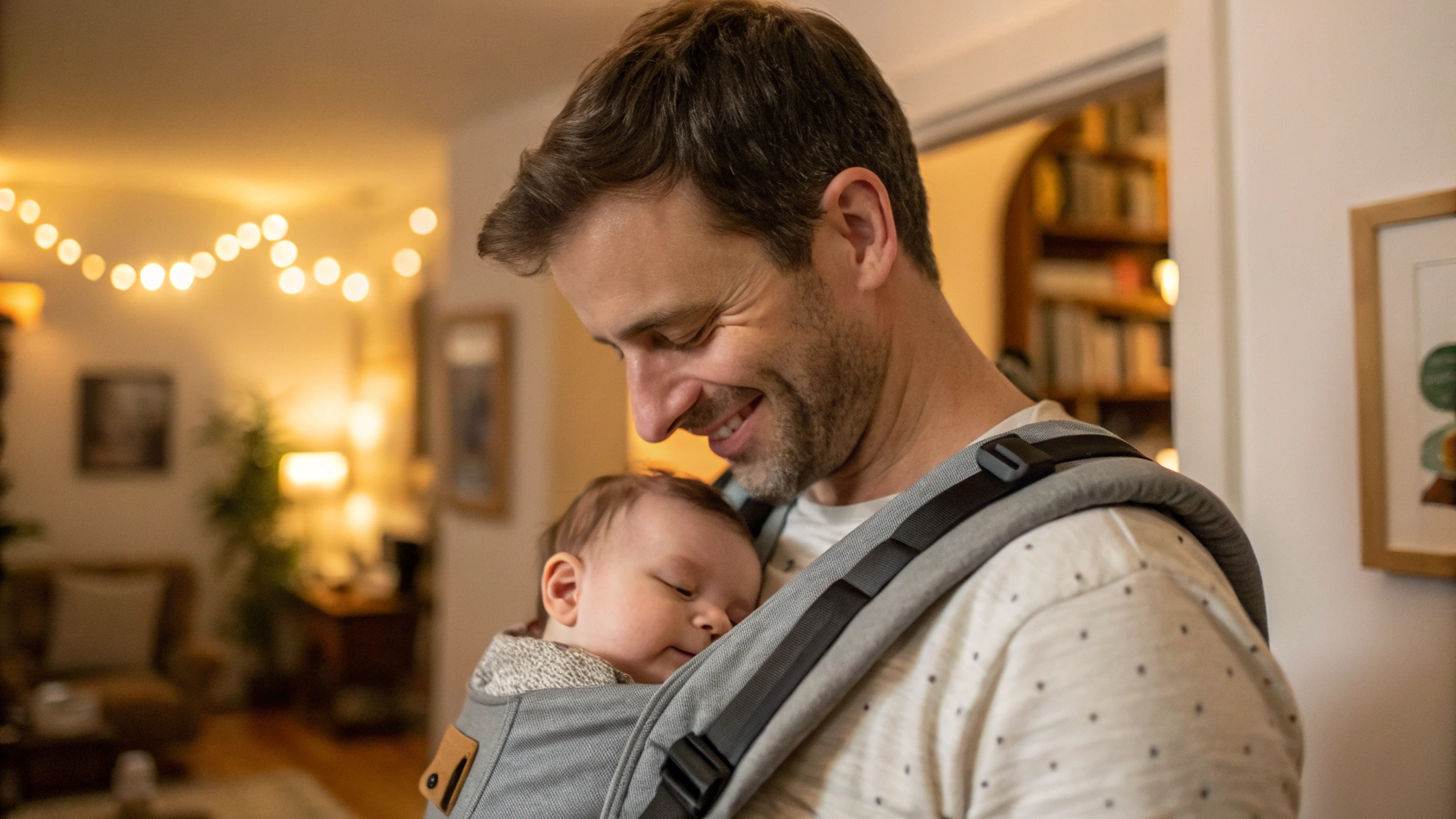Table of Contents
I remember the first time I strapped my newborn into a carrier. I’d read a dozen blogs, watched YouTube tutorials, and still, my heart was pounding. Holding a baby is one thing, but wearing one? That’s next-level. Somewhere between fumbling with the straps and trying not to knock over the coffee table, I got it right — and in that moment, the world felt calmer. This is exactly why finding the perfect dad baby carrier makes such a difference. Not just for comfort, but for connection.
If you’ve ever thought that baby carriers are just for moms, think again. More dads today are discovering the perks — hands-free movement, deep bonding time, and yes, the power to master grocery shopping without wrestling a stroller down narrow aisles.
Why Baby Carriers for Dads Matter
Being able to safely and comfortably carry your baby isn’t just about convenience — it’s about presence. For modern fathers, every cuddle and every gentle sway while walking counts. Studies show that skin-to-skin contact and close physical proximity can help regulate a baby’s temperature, heartbeat, and stress levels.
For many dads, a carrier is freedom. You can take your baby on park walks, attend family outings, or just move around the house without constantly shifting a baby from arm to arm. Plus, babywearing helps dads develop a unique rhythm — your child learns the sound of your footsteps, the pace of your breathing, and begins to associate your presence with comfort and safety.
Trust me — your baby will love that, and you’ll love the confidence it brings.
Choosing the Right Baby Carrier for Dads
Not all carriers are created equal, and when you’re searching for a baby carrier for dads, comfort and practicality should top your list. Here’s what you need to know:
1. Comfort is King
You’ll want wide, padded shoulder straps and a supportive waist belt. This distributes weight evenly, preventing sore shoulders or back strain during longer carries.
2. Adjustability
If your partner also uses the carrier, choose one that adjusts quickly for different body types. Look for strong buckles, sliding straps, and quick-release clips for easy sharing.
3. Baby’s Position & Support
The seat needs to support your baby’s hips in the “M” position (knees higher than bottom) to protect developing joints.
4. Durability & Materials
Breathable, machine-washable fabrics are a lifesaver — trust me, spit-ups happen at the worst possible times.
My Top Dad Baby Carrier Picks
After testing dozens, from outdoor hiking carriers to minimalistic wraps, here are my tried and true winners:

1. Ergobaby Omni Breeze
- Pros: Incredible lumbar support, fits a wide range of body sizes, good airflow.
- Cons: Slight learning curve with straps.
2. BabyBjörn Baby Carrier One
- Pros: Sleek design, lightweight, minimal bulk — great for urban dads.
- Cons: Less lower back support for heavier babies.
3. LÍLLÉbaby Complete All Seasons
- Pros: Six carrying positions, zip-down panel for ventilation.
- Cons: Strap adjustments can be noisy and a bit stiff at first.
How to Wear a Dad Baby Carrier Like a Pro
You might see videos and still feel a bit clumsy. Here’s a step-by-step method that worked for me (and saved a few swear words):
- Loosen straps first — gives you room to position the baby without squishing them.
- Secure the waist belt — this carries most of the weight, so it should sit snugly above your hips.
- Place your baby against your chest — support their head if they can’t hold it up yet.
- Bring shoulder straps over — adjust so they’re tight but not digging in.
- Check posture — baby’s chin up, clear airway, legs in “M” position.
- Walk around for a few minutes — you’ll know immediately if adjustments are needed.
Smart Budget Tips for Babywearing Dads
Not every carrier needs to cost a fortune. A few cost-saving tricks:
- Buy from trusted second-hand stores — many carriers are gently used for only a few months.
- Look for bundle deals from brands or parenting shops.
- DIY cloth wraps — stretchy fabric can double as a wrap carrier for newborns (though they offer less back support than structured carriers).
FAQ
Q: Can I use the same carrier for a newborn and a toddler?
A: Some carriers grow with your child, but check weight limits and newborn insert requirements.
Q: Are wraps or structured carriers better for dads?
A: Structured carriers generally offer more back support for dads, especially as babies get heavier.
Q: Is it safe to carry my baby facing out?
A: Yes, but wait until your baby has good head and neck control (usually ~6 months), and limit time facing out to avoid overstimulation.
Q: What if I have back problems?
A: Go for a carrier with lumbar support and thick waist belts; consult your doctor if in doubt.
Final Thoughts
Babywearing as a dad isn’t just about convenience — it’s about building quiet, unshakable memories. You’ll remember the little kicks against your chest, the way your baby’s breathing slows when they feel you moving, and those tiny fingers grabbing your shirt.
Whether you go for the super-supportive hiking carrier or the lightweight city-friendly model, you’re investing in something more than fabric and buckles — you’re investing in presence. And if you’re anything like me, you’ll find yourself reaching for your dad baby carrier long after your baby has mastered walking, just because you miss the closeness.
